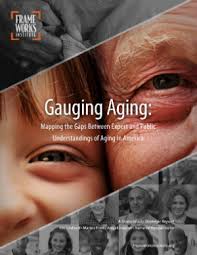A few months ago, a photo of a dress went viral because people saw different things when they looked at it. Was it blue with black stripes, or white with gold stripes? Others disputed whether it mattered and wondered about human divisions and trivial obsessions. The other day, over six weeks after “Dressgate” and less than an hour after I finished the FrameWorks Institute’s “Gauging Aging” report, a grocery store clerk referenced the dress as evidence that “people need to get a life.”

Ironically, the FrameWork’s report, which uncovers two fundamentally different perspectives on aging in America, illustrates just how dangerously different the same thing can appear.
It also shows how the way we see aging may be shaping what aging is, rather than the other way around.
If you are old, or plan to get old, or love anyone old, I recommend you read this report and think about the implications for us as a society and as individuals. The great thing about their work is that they go beyond what people say, as well as myths and stereotypes about aging, to identify and explore underlying assumptions and ways of thinking.
Bottom line:
- experts see aging as normal, varied, and distinct from disease and decline, and they can think of many ways in which our policies and approaches can transform aging, increase wellness and independence, productivity and satisfaction
- the public, by contrast, has a largely negative, individualist, and fatalistic view of aging. They also aren’t aware of how much and how permanently the country is aging, how social and economic choices influence the experience of aging, or the pervasiveness of age bias.
I should mention that FrameWorks got an organizational MacArthur (they of “genius” grant fame) for creative and effective institutions last year, so it seems safe to assume they know what they’re doing (!)

John Beilenson of SCP and I lead a group through the American Geriatrics Society that is working on how we communicate about geriatrics to the public, system leaders, colleagues, trainees, and policymakers. After all, if you’ve been sending out the same message for decades, even if it’s about proven good and important work and is backed up by data, and still most people don’t understand what you do, you have a communications problem.
This was made painfully clear a couple of years ago in a (tragic, funny, heartbreaking) video by Hopkins researchers in which they asked Baltimoreans “What is a geriatrician?” Lots of smart people from all walks of life had no clue. They also had some thoughtful and funny guesses. (No, it’s not related to either juries or Ben & Jerry’s ice cream…)
Of course, I also try to do my part by writing. In my recent piece for the Narrative Matters section of Health Affairs, I did that writerly thing of trying to ‘show’ what’s different about geriatrics while also telling the story of my chance encounter with a terrific octogenarian.
Today, the Washington Post published a slightly shorter version of the same essay with a picture that strikes me as a sort of Rorschach test of one’s feelings about aging:

I see this and love it – and not just because the doctor in it resembles a somewhat younger, taller me. I love it because i see the walker and the white hair but because i met this woman, so I also know she was smart and funny and only just then retiring and figuring out what to do next in her life.
I am biased, to be sure. But the FrameWorks people aren’t. They research all kinds of issues. And their report, the first in a series, should be mandatory reading for anyone who thinks ‘silver tsunami’ is an apt term for the aging of our population, or that being old = being ill and useless, or that aging is a private, individual issue, not one that can be shaped – and improved – by our choices as a society.
